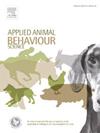Do looks matter? Investigating facial expressions and intraspecific communication across different dog morphotypes
IF 2
2区 农林科学
Q1 AGRICULTURE, DAIRY & ANIMAL SCIENCE
引用次数: 0
Abstract
Brachycephalic dogs gained great popularity in recent years, however the extreme conformation (e.g., wide eyes, flat nose, round heads, short tails) characterizing some breeds raised concerns about the effectiveness of facial signals in these dogs. These features might create challenges for an effective intraspecific communication and potentially lead to misunderstandings during intraspecific interactions. This study aimed to investigate potential differences in behavioural displays during intraspecific approaches between dogs of different morphotypes: hunting dogs and shepherd dogs (mesocephalic morphotype) and small companion molossoids and guard molossoids (brachycephalic morphotype). Fourteen brachycephalic dogs and sixteen mesocephalic dogs were tested. We predicted that mesocephalic and brachycephalic would express facial signals at different extent and that if brachycephalic dog facial signaling is impaired by their facial conformation it could elicit different responses in the opponent dog. Contrary to our predictions, no behavioural differences were found between brachycephalic and mesocephalic breeds, suggesting that extreme conformation of brachycephalic dogs has not drastically altered their communicative abilities. Further results showed that the “tongue flicking” behaviour, previously suggested to function as an early warning in conflicted/aggressions-related contexts was performed more by mesocephalic TESTED DOGS when the DOG STIMULUS was a brachycephalic dog, suggesting that this morphotype can elicit intense and ambiguous response in mesocephalic dogs. Conversely, the “bow” behaviour, a stereotyped cue consistently found in canids intraspecific social contexts, was expressed more by the mesocephalic TESTED DOG towards other mesocephalic approaching DOG STIMULI. Different behavioural patterns associated to the specific breed types tested emerged: shepherd dogs showed higher alertness and dog orientation, hunting dogs barked more, guard molossoids showed calm vigilance and small companion molossoids were more avoidant in regards of the dog approaching them. The present study is the first aimed to examine if the brachycephalic morphotype influences dogs’ intraspecific communication and due to the limited number of dogs tested further experimental evidences are needed. Nevertheless, it appears that brachycephalic dogs are perceived differently by non-brachycephalic ones and these results could provide valuable insights for researchers, breeders and dog trainers.
外表重要吗?研究不同形态狗的面部表情和种内交流
近年来,短头犬非常受欢迎,然而,一些品种的极端构造(例如,大眼睛,扁鼻子,圆头,短尾)的特征引起了人们对这些狗面部信号有效性的担忧。这些特征可能会给有效的种内交流带来挑战,并可能导致种内互动过程中的误解。本研究旨在探讨不同形态的狗在种内接近时行为表现的潜在差异:猎犬和牧羊犬(中头型),小伴侣和守卫型(短头型)。对14只短头犬和16只中头犬进行了测试。我们预测中脑和短头狗的面部信号表达程度不同,如果短头狗的面部构象受损,可能会引起对手狗的不同反应。与我们的预测相反,在短头畸形犬和中头畸形犬之间没有发现行为差异,这表明短头畸形犬的极端构象并没有彻底改变它们的交流能力。进一步的结果表明,“轻弹舌头”行为,先前被认为是在冲突/攻击相关的环境中作为早期预警的功能,在中脑测试的狗身上表现得更多,当狗的刺激是短头狗时,这表明这种形态可以引起中脑狗强烈而模糊的反应。相反,“鞠躬”行为,一种在犬科动物种内社会环境中普遍存在的刻板线索,在中脑测试的狗对其他中脑接近的狗刺激时表现得更多。与特定品种类型相关的不同行为模式出现了:牧羊犬表现出更高的警惕性和狗的方向性,猎狗吠得更多,看守的软体动物表现出冷静的警惕,而小伴侣软体动物在狗接近它们时更回避。本研究首次旨在研究短头畸形是否会影响狗的种内交流,由于测试的狗数量有限,需要进一步的实验证据。然而,似乎短头畸形狗与非短头畸形狗的感知不同,这些结果可以为研究人员,育种者和狗训练员提供有价值的见解。
本文章由计算机程序翻译,如有差异,请以英文原文为准。
求助全文
约1分钟内获得全文
求助全文
来源期刊

Applied Animal Behaviour Science
农林科学-行为科学
CiteScore
4.40
自引率
21.70%
发文量
191
审稿时长
18.1 weeks
期刊介绍:
This journal publishes relevant information on the behaviour of domesticated and utilized animals.
Topics covered include:
-Behaviour of farm, zoo and laboratory animals in relation to animal management and welfare
-Behaviour of companion animals in relation to behavioural problems, for example, in relation to the training of dogs for different purposes, in relation to behavioural problems
-Studies of the behaviour of wild animals when these studies are relevant from an applied perspective, for example in relation to wildlife management, pest management or nature conservation
-Methodological studies within relevant fields
The principal subjects are farm, companion and laboratory animals, including, of course, poultry. The journal also deals with the following animal subjects:
-Those involved in any farming system, e.g. deer, rabbits and fur-bearing animals
-Those in ANY form of confinement, e.g. zoos, safari parks and other forms of display
-Feral animals, and any animal species which impinge on farming operations, e.g. as causes of loss or damage
-Species used for hunting, recreation etc. may also be considered as acceptable subjects in some instances
-Laboratory animals, if the material relates to their behavioural requirements
 求助内容:
求助内容: 应助结果提醒方式:
应助结果提醒方式:


